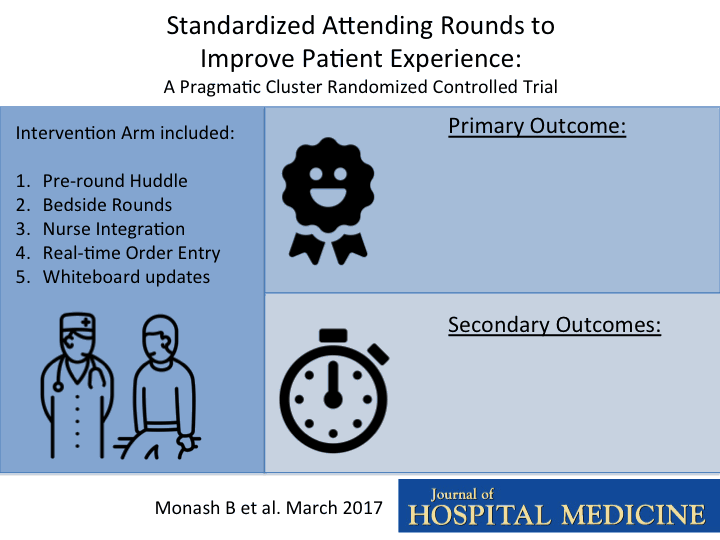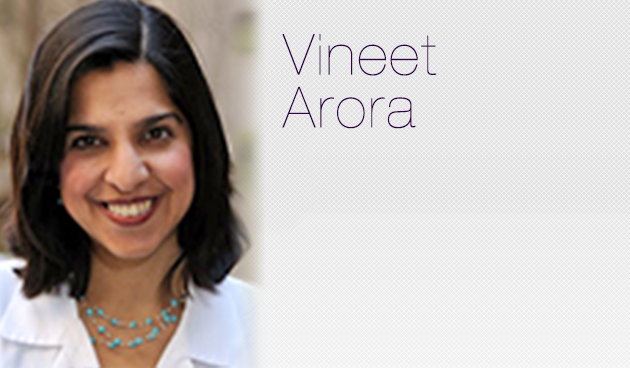The term “patient-centered” has become a healthcare buzzword and was certainly popularized by the creation of the patient-centered medical home in ambulatory care. In the inpatient world, patient-centered rounds symbolizes this effort to improve patient experience and is the subject of a new study in this month’s Journal of Hospital Medicine, which we’ll discuss on next Monday’s #JHMChat at 9 p.m. EST on Twitter.
In a randomized trial, Brad Monash and UCSF colleagues explored the impact of patient-centered rounds on patient experience. Patient-centered rounds was a bundle of 5 evidence-based practices: 1) pre-rounds huddle; 2) bedside rounds; 3) nurse integration; 4) real-time order entry; and 5) whiteboard updates. The control group continued with routine practice of attending rounds.
The study was impressive for several reasons, but one in particular caught my attention – an army of 30 pre-med students volunteered to be observers (and also get shadowing experience?) to monitor adherence. Adherence rates varied from 29% (use of whiteboard) to 78% (pre-round huddle). Bedside rounds during only half of patient encounters during patient-centered rounds. Regardless, these activities occurred infrequently in routine attending rounds.
The results? Patients liked this new model. The rounds clocked in a few minutes shorter, too. Despite this, the residents felt that patient-centered rounds were longer and were less satisfied with the new system. Specifically, residents perceived patient-centered rounds as less efficient and less educational with less autonomy to make decisions.

Not surprisingly, prior efforts to make things more patient-centered are sometimes not seen as friendly towards physicians. One reason for that is that the patient-centeredness occurs at the expense of doctors. In fact, The Doctor Crisis describes how Kaiser Permanente Colorado recognized this and actually demoted “patient-centered care”, instead moving “preservation and enhancement of career” to the top goal for their doctors. However, the Monash study also took place with residents, which leads to even more interesting questions about what residency education should and should not be:
- What is the main goal of “attending rounds”? Another recent study that included my home institution as a site highlighted that residents perceive the main purpose of rounds to be to develop a care plan for patients, but that there was a tension due to the need to educate patients. As the paper outlined, “Some residents voiced frustration that the needs of the family superseded their own, or that the presence of families constrained academic discussion of patients.” Can “attending rounds” serve this dual purpose for resident education and patient care? This actually leads to the next question…
- What is “educational” vs “service” to residents? This age-old question flummoxes many program directors and is asked yearly on the ACGME survey to all residents in the nation. In fact, the Association of Program Directors in Internal Medicine recently put forward a white paper to address how to reconcile definitions. Is helping a patient understand their condition and important educational experience? Of course, it is. However, residents also perceive repetitive work or excessive workloads to be more “service” that compromises education. Where do you draw the line?
- Can system redesign promote and improve patient and resident satisfaction? We don’t know the team census in the Monash study, but I am guessing that patient-centered rounds took place on the backdrop of a pretty busy service given that it is a tertiary care medical center. In another study, a patient-centered curriculum plus a reduced workload was associated with increased resident satisfaction and patient satisfaction. This gets at a larger question of how to restore the joy in work for doctors- and maybe it is more time to reflect and care for patients.
Our healthcare system should be patient-centered, but it’s also time to make sure resident education is not left behind. These were just a few of the thoughts I had reading this paper; I am sure you may have some of your own. Join us next Monday, March 13 at 9 p.m. EST when we discuss this paper in depth on our CME-certified #JHMChat with the author, Brad Monash.
#JHMChat is held on the 2nd Monday of every month (i.e. March 13, April 10, and May 8). In addition to standardized attending rounds, upcoming topics on the schedule include dealing with VIP patients and reducing overuse. Participation to continues to grow, and we’re hoping join and spread the word to colleagues and friends!



Leave A Comment